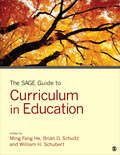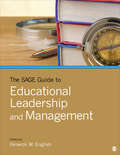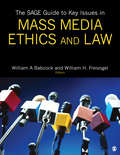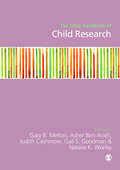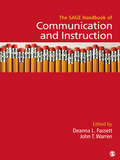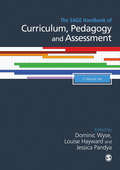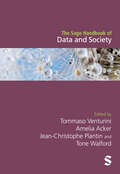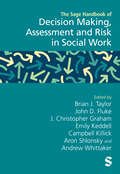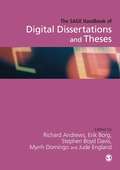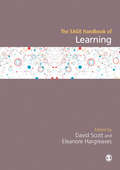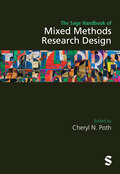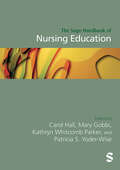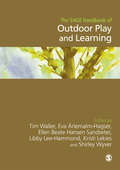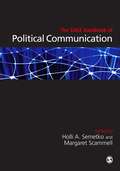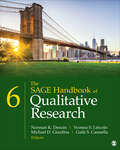- Table View
- List View
The SAGE Guide to Curriculum in Education
by Dr Ming Fang He Dr Brian D. Schultz Dr William H. SchubertThe SAGE Guide to Curriculum in Education integrates, summarizes, and explains, in highly accessible form, foundational knowledge and information about the field of curriculum with brief, simply written overviews for people outside of or new to the field of education. This Guide supports study, research, and instruction, with content that permits quick access to basic information, accompanied by references to more in-depth presentations in other published sources. This Guide lies between the sophistication of a handbook and the brevity of an encyclopedia. It addresses the ties between and controversies over public debate, policy making, university scholarship, and school practice. While tracing complex traditions, trajectories, and evolutions of curriculum scholarship, the Guide illuminates how curriculum ideas, issues, perspectives, and possibilities can be translated into public debate, school practice, policy making, and life of the general public focusing on the aims of education for a better human condition. 55 topical chapters are organized into four parts: Subject Matter as Curriculum, Teachers as Curriculum, Students as Curriculum, and Milieu as Curriculum based upon the conceptualization of curriculum commonplaces by Joseph J. Schwab: subject matter, teachers, learners, and milieu. The Guide highlights and explicates how the four commonplaces are interdependent and interconnected in the decision-making processes that involve local and state school boards and government agencies, educational institutions, and curriculum stakeholders at all levels that address the central curriculum questions: What is worthwhile? What is worth knowing, needing, experiencing, doing, being, becoming, overcoming, sharing, contributing, wondering, and imagining? The Guide benefits undergraduate and graduate students, curriculum professors, teachers, teacher educators, parents, educational leaders, policy makers, media writers, public intellectuals, and other educational workers. Key Features: Each chapter inspires readers to understand why the particular topic is a cutting edge curriculum topic; what are the pressing issues and contemporary concerns about the topic; what historical, social, political, economic, geographical, cultural, linguistic, ecological, etc. contexts surrounding the topic area; how the topic, relevant practical and policy ramifications, and contextual embodiment can be understood by theoretical perspectives; and how forms of inquiry and modes of representation or expression in the topic area are crucial to develop understanding for and make impact on practice, policy, context, and theory. Further readings and resources are provided for readers to explore topics in more details.
The SAGE Guide to Curriculum in Education
by Dr Ming Fang He Dr Brian D. Schultz Dr William H. SchubertThe SAGE Guide to Curriculum in Education integrates, summarizes, and explains, in highly accessible form, foundational knowledge and information about the field of curriculum with brief, simply written overviews for people outside of or new to the field of education. This Guide supports study, research, and instruction, with content that permits quick access to basic information, accompanied by references to more in-depth presentations in other published sources. This Guide lies between the sophistication of a handbook and the brevity of an encyclopedia. It addresses the ties between and controversies over public debate, policy making, university scholarship, and school practice. While tracing complex traditions, trajectories, and evolutions of curriculum scholarship, the Guide illuminates how curriculum ideas, issues, perspectives, and possibilities can be translated into public debate, school practice, policy making, and life of the general public focusing on the aims of education for a better human condition. 55 topical chapters are organized into four parts: Subject Matter as Curriculum, Teachers as Curriculum, Students as Curriculum, and Milieu as Curriculum based upon the conceptualization of curriculum commonplaces by Joseph J. Schwab: subject matter, teachers, learners, and milieu. The Guide highlights and explicates how the four commonplaces are interdependent and interconnected in the decision-making processes that involve local and state school boards and government agencies, educational institutions, and curriculum stakeholders at all levels that address the central curriculum questions: What is worthwhile? What is worth knowing, needing, experiencing, doing, being, becoming, overcoming, sharing, contributing, wondering, and imagining? The Guide benefits undergraduate and graduate students, curriculum professors, teachers, teacher educators, parents, educational leaders, policy makers, media writers, public intellectuals, and other educational workers. Key Features: Each chapter inspires readers to understand why the particular topic is a cutting edge curriculum topic; what are the pressing issues and contemporary concerns about the topic; what historical, social, political, economic, geographical, cultural, linguistic, ecological, etc. contexts surrounding the topic area; how the topic, relevant practical and policy ramifications, and contextual embodiment can be understood by theoretical perspectives; and how forms of inquiry and modes of representation or expression in the topic area are crucial to develop understanding for and make impact on practice, policy, context, and theory. Further readings and resources are provided for readers to explore topics in more details.
The SAGE Guide to Educational Leadership and Management
by Dr Fenwick W. EnglishThe SAGE Guide to Educational Leadership and Management allows readers to gain knowledge of educational management in practice while providing insights into challenges facing educational leaders and the strategies, skills, and techniques needed to enhance administrative performance. This guide emphasizes the important skills that effective leaders must develop and refine, including communication, developing teams, coaching and motivating, and managing time and priorities. While being brief, simply written, and a highly practical overview for individuals who are new to this field, this reference guide will combine practice and research, indicate current issues and directions, and choices that need to be made. Features & Benefits: 30 brief, signed chapters are organized in 10 thematic parts in one volume available in a choice of electronic or print formats designed to enable quick access to basic information. Selective boxes enrich and support the narrative chapters with case examples of effective leadership in action. Chapters conclude with bibliographic endnotes and references to further readings to guide students to more in-depth presentations in other published sources. Back matter includes an annotated listing of organizations, associations, and journals focused on educational leadership and administration and a detailed index. This reference guide will serve as a vital source of knowledge to any students pursuing an education degree as well as for individuals interested in the subject matter that do not have a strong foundation of the topic.
The SAGE Guide to Educational Leadership and Management
by Dr Fenwick W. EnglishThe SAGE Guide to Educational Leadership and Management allows readers to gain knowledge of educational management in practice while providing insights into challenges facing educational leaders and the strategies, skills, and techniques needed to enhance administrative performance. This guide emphasizes the important skills that effective leaders must develop and refine, including communication, developing teams, coaching and motivating, and managing time and priorities. While being brief, simply written, and a highly practical overview for individuals who are new to this field, this reference guide will combine practice and research, indicate current issues and directions, and choices that need to be made. Features & Benefits: 30 brief, signed chapters are organized in 10 thematic parts in one volume available in a choice of electronic or print formats designed to enable quick access to basic information. Selective boxes enrich and support the narrative chapters with case examples of effective leadership in action. Chapters conclude with bibliographic endnotes and references to further readings to guide students to more in-depth presentations in other published sources. Back matter includes an annotated listing of organizations, associations, and journals focused on educational leadership and administration and a detailed index. This reference guide will serve as a vital source of knowledge to any students pursuing an education degree as well as for individuals interested in the subject matter that do not have a strong foundation of the topic.
The SAGE Guide to Key Issues in Mass Media Ethics and Law
by Dr William Babcock William H. FreivogelThe SAGE Guide to Key Issues in Mass Media Ethics and Law is an authoritative and rigorous two-volume, issues-based reference set that surveys varied views on many of the most contentious issues involving mass media ethics and the law. Divided into six thematic sections covering information from contrasting ethical responsibly and legal rights for both speech and press, newsgathering and access, and privacy to libelous reporting, business considerations, and changing rules with social media and the Internet, the information in this guide is extremely relevant to a variety of audiences. This guide specifically focuses on matters that are likely to be regular front-page headlines concerning topics such as technological threats to privacy, sensationalism in media coverage of high-profile trials, cameras in the courtroom, use of confidential sources, national security concerns and the press, digital duplication and deception, rights of celebrities, plagiarism, and more. Collectively, this guide assesses key contentious issues and legal precedents, noting current ethical and legal trends and likely future directions. Features: Six thematic sections consist of approximately a dozen chapters each written by eminent scholars and practitioners active in the field. Sections open with a general Introduction by the volume editors and conclude with a wrap-up “Outlook” section to highlight likely future trends. Chapters follow a common organizational outline of a brief overview of the issue at hand, historical background and precedent, and presentation of various perspectives (pro, con, mixed) to the issue. “See also” cross references guide readers to related chapters and references and further readings guide users to more in-depth resources for follow-up. This reference guide is an excellent source for the general public, students, and researchers who are interested in expanding their knowledge in mass media and the ethics and law surrounding it.
The SAGE Guide to Key Issues in Mass Media Ethics and Law
by Dr William Babcock William H. FreivogelThe SAGE Guide to Key Issues in Mass Media Ethics and Law is an authoritative and rigorous two-volume, issues-based reference set that surveys varied views on many of the most contentious issues involving mass media ethics and the law. Divided into six thematic sections covering information from contrasting ethical responsibly and legal rights for both speech and press, newsgathering and access, and privacy to libelous reporting, business considerations, and changing rules with social media and the Internet, the information in this guide is extremely relevant to a variety of audiences. This guide specifically focuses on matters that are likely to be regular front-page headlines concerning topics such as technological threats to privacy, sensationalism in media coverage of high-profile trials, cameras in the courtroom, use of confidential sources, national security concerns and the press, digital duplication and deception, rights of celebrities, plagiarism, and more. Collectively, this guide assesses key contentious issues and legal precedents, noting current ethical and legal trends and likely future directions. Features: Six thematic sections consist of approximately a dozen chapters each written by eminent scholars and practitioners active in the field. Sections open with a general Introduction by the volume editors and conclude with a wrap-up “Outlook” section to highlight likely future trends. Chapters follow a common organizational outline of a brief overview of the issue at hand, historical background and precedent, and presentation of various perspectives (pro, con, mixed) to the issue. “See also” cross references guide readers to related chapters and references and further readings guide users to more in-depth resources for follow-up. This reference guide is an excellent source for the general public, students, and researchers who are interested in expanding their knowledge in mass media and the ethics and law surrounding it.
The SAGE Handbook of Child Research
by Ms Natalie K. Worley Gail S. Goodman Ms Judith Cashmore Mr Asher Ben-Arieh Dr Gary B. Melton"It is refreshing to see a book such as this which is both broad in its conceptualization of the field of child research and deep in its focus. The volume's editors are paragons of awareness when it comes to the need for interdisciplinary research and theory to illuminate the lives and experience of children." - James Garbarino, Loyola University Chicago "Covers a satisfying and unprecedentedly wide range of research relating to childhood. The contributors include many eminent international scholars of childhood, making the book a valuable resource for child researchers. Child advocates will also find the book to be invaluable in their efforts to improve children's well-being, and to change policies and practices for the better." - Anne Smith, University of Otago "A really scintillating collection that will provide a lasting perspective on child studies - stimulating and comprehensive!" - Jonathan Bradshaw, University of York In keeping with global changes in children's social and legal status, this Handbook includes examination of children as family members, friends, learners, consumers, people of faith, and participants in law and politics. The contributors also discuss the methodological and ethical requirements for research that occurs in natural settings and that enables children themselves to describe their perspective. The book is divided into three parts: Part I: Setting-Specific Issues in Child Research Part II: Population-Specific Issues in Child Research Part III: Methods in Research on Children and Childhood
The SAGE Handbook of Communication and Instruction
by Dr Deanna L. Fassett Dr John T. WarrenAs the only multi-paradigmatic collection of research in the field, this Handbook brings together a comprehensive range of essays to serve as a fully inclusive resource. Deanna L. Fassett and John T. Warren, along with two section editors and twenty-nine additional contributors, provide a balanced overview of various paradigms in the field—social scientific, interpretive, and critical. Key Features Three sections, addressing overlapping issues in communication and instruction, collectively represent multiple paradigms. This allows the reader to experience the depth and nuance available in communications studies.Each perspective is granted its own foundational chapter to provide an orientation to the discipline. Each contributor sets the agenda for their approach, helping the reader identify where the field is headed and where future research might be beneficial.Besides reviews of extant literature, demonstrating where the field has been, this Handbook also includes chapters that share topical new findings.
The SAGE Handbook of Curriculum, Pedagogy and Assessment
by Ms Jessica Pandya Professor Dominic Wyse Ms Louise HaywardThe research and debates surrounding curriculum, pedagogy and assessment are ever-growing and are of constant importance around the globe. With two volumes - containing chapters from highly respected researchers, whose work has been critical to understanding and building expertise in the field - The SAGE Handbook of Curriculum, Pedagogy and Assessment focuses on examining how curriculum is treated and developed, and its impact on pedagogy and assessment worldwide. The Handbook is organised into five thematic sections, considering: · The epistemology and methodology of curriculum · Curriculum and pedagogy · Curriculum subjects · Areas of the curriculum · Assessment and the curriculum · The curriculum and educational policy The SAGE Handbook of Curriculum, Pedagogy and Assessment's breadth and rigour will make it essential reading for researchers and postgraduate students around the world.
The Sage Handbook of Data and Society
by Tommaso Venturini Amelia Acker Jean-Christophe Plantin Tone WalfordThe Sage Handbook of Data and Society provides a comprehensive exploration of the impact of data on society. Addressing urgent research questions in this rapidly evolving field and offering a balanced mix of introductory insights and advanced analyses, this resource offers a nuanced understanding of critical data studies and their relevance to contemporary society. Through detailed examinations of specific issues, cases, concepts, and methodologies, the handbook fosters a critical proximity to the entanglement of social dynamics and their data doubles. Organized into seven sections, the handbook covers a diverse range of topics, including data infrastructures, digital labor, power dynamics, environmental challenges, bodily experiences, scientific methodologies, and disciplinary intersections. Each section offers a broad examination of critical issues, highlighting interdisciplinary scholarship and presenting fresh perspectives on the intricate relationship between data and societal structures. Featuring contributions from scholars representing various disciplines and global perspectives, The Sage Handbook of Data and Society is an invaluable resource for scholars, researchers, students, and practitioners. By encouraging critical engagement with the profound impacts of datafication, this handbook equips readers with the necessary tools to navigate the complexities of the digital age and comprehend its implications for contemporary society. Section 1: Infrastructures of Data Section 2: Labor of Data Section 3: Power and Struggles of Data Section 4: Data and Crises of Nature Section 5: Data and Bodies Section 6: The Sciences of Data Section 7: Disciplines of Data
The Sage Handbook of Data and Society
by Tommaso Venturini Amelia Acker Jean-Christophe Plantin Tone WalfordThe Sage Handbook of Data and Society provides a comprehensive exploration of the impact of data on society. Addressing urgent research questions in this rapidly evolving field and offering a balanced mix of introductory insights and advanced analyses, this resource offers a nuanced understanding of critical data studies and their relevance to contemporary society. Through detailed examinations of specific issues, cases, concepts, and methodologies, the handbook fosters a critical proximity to the entanglement of social dynamics and their data doubles. Organized into seven sections, the handbook covers a diverse range of topics, including data infrastructures, digital labor, power dynamics, environmental challenges, bodily experiences, scientific methodologies, and disciplinary intersections. Each section offers a broad examination of critical issues, highlighting interdisciplinary scholarship and presenting fresh perspectives on the intricate relationship between data and societal structures. Featuring contributions from scholars representing various disciplines and global perspectives, The Sage Handbook of Data and Society is an invaluable resource for scholars, researchers, students, and practitioners. By encouraging critical engagement with the profound impacts of datafication, this handbook equips readers with the necessary tools to navigate the complexities of the digital age and comprehend its implications for contemporary society. Section 1: Infrastructures of Data Section 2: Labor of Data Section 3: Power and Struggles of Data Section 4: Data and Crises of Nature Section 5: Data and Bodies Section 6: The Sciences of Data Section 7: Disciplines of Data
The Sage Handbook of Decision Making, Assessment and Risk in Social Work
by Brian J. Taylor John D. Fluke J. Christopher Graham Emily Keddell Campbell Killick Aron Shlonsky Andrew WhittakerThe SAGE Handbook on Decision Making, Assessment and Risk in Social Work provides a comprehensive overview of key strands of research and theoretical concepts in this increasingly important field. With 49 chapters and four section summaries, this Handbook describes the ‘state of the art’; discuss key debates and issues; and gives pointers on future directions for practice, research, teaching, management of services, and development of theoretical understandings. A key aim of this Handbook is to support the development of sound, applied knowledge and values to underpin reasoned professional judgement and decision making by social workers in practice and those in management and regulatory roles. With contributions from a global interdisciplinary body of leading and emerging scholars from a wide variety of roles, this handbook has been designed to be internationally generalisable and applicable to all major areas of social work. This Handbook provides a field-defining account of decision making, assessment and risk in social work which is unrivalled for its diversity and strength of coverage, and will be of value to social work researchers, teachers and practitioners, as well as to those in allied fields such as health care. Section 1: Professional Judgement Section 2: Assessment, Risk and Decision Processes Section 3: Assessment Tools and Approaches Section 4: Developing and Managing Practice Section 5: Concluding Section / Afterword
The Sage Handbook of Decision Making, Assessment and Risk in Social Work
by Brian J. Taylor John D. Fluke J. Christopher Graham Emily Keddell Campbell Killick Aron Shlonsky Andrew WhittakerThe SAGE Handbook on Decision Making, Assessment and Risk in Social Work provides a comprehensive overview of key strands of research and theoretical concepts in this increasingly important field. With 49 chapters and four section summaries, this Handbook describes the ‘state of the art’; discuss key debates and issues; and gives pointers on future directions for practice, research, teaching, management of services, and development of theoretical understandings. A key aim of this Handbook is to support the development of sound, applied knowledge and values to underpin reasoned professional judgement and decision making by social workers in practice and those in management and regulatory roles. With contributions from a global interdisciplinary body of leading and emerging scholars from a wide variety of roles, this handbook has been designed to be internationally generalisable and applicable to all major areas of social work. This Handbook provides a field-defining account of decision making, assessment and risk in social work which is unrivalled for its diversity and strength of coverage, and will be of value to social work researchers, teachers and practitioners, as well as to those in allied fields such as health care. Section 1: Professional Judgement Section 2: Assessment, Risk and Decision Processes Section 3: Assessment Tools and Approaches Section 4: Developing and Managing Practice Section 5: Concluding Section / Afterword
The SAGE Handbook of Digital Dissertations and Theses: SAGE Publications
by Mr Richard N. L. Andrews Erik Borg Myrrh Domingo Jude England Stephen N. DavisThis handbook sets out the processes and products of 'digital' research. It is a theoretical and practical guide on how to undertake and navigate advanced research in the arts, humanities and social sciences. Topics covered include: - how to make research more accessible - the use of search engines and other sources to determine the scope of work - research training for students - what will theses, dissertations and research reports look like in ten years' time? - the storing and archiving of such research - ethics and methodologies in the field - intercultural issues The editors focus on advances in arts and practice-based doctorates, and their application in other fields and disciplines. The contributions chart new territory for universities, research project directors, supervisors and research students regarding the nature and format of Masters and doctoral work, as well as research projects. This handbook is an essential reference for researchers, supervisors and administrators on how to conduct and evaluate research projects in a digital and multimodal age. Richard Andrews is Professor in English, Faculty of Children and Learning, Institute of Education. Erik Borg is a Senior Lecturer at Coventry University's Centre for Academic Writing. Stephen Boyd Davis is Research Leader in the School of Design, Royal College of Art. Myrrh Domingo is Visiting Assistant Professor in English Education and Literacy Education at New York University. Jude England is Head of Social Sciences at the British Library.
The SAGE Handbook of Learning
by Dr Eleanore Hargreaves Professor David Scott"Profound and useful, readers will benefit from the systematic treatment of learning through superb scholarship. Cultural-philosophical-curricular-pedagogical-historical perspectives on learning, curriculum, pedagogy, and assessment, and learners make this collection unique." - Carol A. Mullen, Professor of Educational Leadership, Virginia Tech Learning is a fundamental topic in education. Combining traditional views of learning and learning theory with sociocultural and historical perspectives, this Handbook brings together original contributions from respected researchers who are leading figures in the field. The editors provide a insightful introduction to the topic, and the theories, frameworks, themes and issues discussed in the individual chapters are central to each and every learning episode. The Handbook is organized into four sections, each beginning with a short introduction: Philosophical, Sociological and Psychological Theories of Learning Models of Learning Learning, Curriculum, Pedagogy and Assessment Learning Dispositions, Life-Long Learning and Learning Environments
The SAGE Handbook of Learning
by Dr Eleanore Hargreaves Professor David Scott"Profound and useful, readers will benefit from the systematic treatment of learning through superb scholarship. Cultural-philosophical-curricular-pedagogical-historical perspectives on learning, curriculum, pedagogy, and assessment, and learners make this collection unique." - Carol A. Mullen, Professor of Educational Leadership, Virginia Tech Learning is a fundamental topic in education. Combining traditional views of learning and learning theory with sociocultural and historical perspectives, this Handbook brings together original contributions from respected researchers who are leading figures in the field. The editors provide a insightful introduction to the topic, and the theories, frameworks, themes and issues discussed in the individual chapters are central to each and every learning episode. The Handbook is organized into four sections, each beginning with a short introduction: Philosophical, Sociological and Psychological Theories of Learning Models of Learning Learning, Curriculum, Pedagogy and Assessment Learning Dispositions, Life-Long Learning and Learning Environments
The Sage Handbook of Mixed Methods Research Design
by Cheryl N. PothWith contributions from over 80 of the biggest names and rising stars of the field, this Handbook is an essential resource for anyone interested in the contemporary, emerging, and evolving practice of mixed methods research and scholarship. Exploring new and novel applications of existing mixed methods research design practices, the handbook provides comprehensive integration guidance while showcasing how design innovations inspire and contribute to investigating previously under-researched social issues and populations. Through its unique focus on design and the diverse contexts in which mixed methods research is being applied, this Handbook prepares researchers for the changing conditions in which they will conduct studies. Newcomers and seasoned mixed methods researchers alike will find this Handbook a go-to source for tools to think and act ‘complexively’ and creatively in research design. Using accessible language and illustrative examples, this Handbook is written for those with various roles and experience in mixed methods research design. The in-depth discussions led by the interdisciplinary group of 11 internationally renowned editorial section leads project our collective thinking of mixed methods research design into the future across the following six sections: Section 1: Inspiring Diversity and Innovation in Mixed Methods Design Section 2: The Craft of Mixed Methods Research Design Section 3: Expanding Mixed Methods Design Approaches Section 4: Designing Innovative Integrations with Technology Section 5: Navigating Research Cultures in Mixed Methods Design Section 6: Exploring Design Possibilities and Challenges for Mixed Methods Research
The Sage Handbook of Mixed Methods Research Design
by Cheryl N. PothWith contributions from over 80 of the biggest names and rising stars of the field, this Handbook is an essential resource for anyone interested in the contemporary, emerging, and evolving practice of mixed methods research and scholarship. Exploring new and novel applications of existing mixed methods research design practices, the handbook provides comprehensive integration guidance while showcasing how design innovations inspire and contribute to investigating previously under-researched social issues and populations. Through its unique focus on design and the diverse contexts in which mixed methods research is being applied, this Handbook prepares researchers for the changing conditions in which they will conduct studies. Newcomers and seasoned mixed methods researchers alike will find this Handbook a go-to source for tools to think and act ‘complexively’ and creatively in research design. Using accessible language and illustrative examples, this Handbook is written for those with various roles and experience in mixed methods research design. The in-depth discussions led by the interdisciplinary group of 11 internationally renowned editorial section leads project our collective thinking of mixed methods research design into the future across the following six sections: Section 1: Inspiring Diversity and Innovation in Mixed Methods Design Section 2: The Craft of Mixed Methods Research Design Section 3: Expanding Mixed Methods Design Approaches Section 4: Designing Innovative Integrations with Technology Section 5: Navigating Research Cultures in Mixed Methods Design Section 6: Exploring Design Possibilities and Challenges for Mixed Methods Research
The Sage Handbook of Nursing Education
by Carol Hall Patricia S. Yoder-Wise Mary Gobbi Kathryn Whitcomb ParkerIn the past several years, a revival of research devoted to nursing education has emerged. This emergence has changed the way many educators engage in their practice of working with learners; and learners have come to expect that they will have a rich learning experience designed to develop new (or enhance prior) knowledge, skills, and attitudes. The SAGE Handbook of Nursing Education provides a detailed map of the current discipline, with a carefully selected team of international contributors offering the latest thinking about education in nursing across key areas. This handbook will be a key resource for academic educators, as well as graduate and postgraduate learners.
The Sage Handbook of Nursing Education
by Carol Hall Patricia S. Yoder-Wise Mary Gobbi Kathryn Whitcomb ParkerIn the past several years, a revival of research devoted to nursing education has emerged. This emergence has changed the way many educators engage in their practice of working with learners; and learners have come to expect that they will have a rich learning experience designed to develop new (or enhance prior) knowledge, skills, and attitudes. The SAGE Handbook of Nursing Education provides a detailed map of the current discipline, with a carefully selected team of international contributors offering the latest thinking about education in nursing across key areas. This handbook will be a key resource for academic educators, as well as graduate and postgraduate learners.
The SAGE Handbook of Outdoor Play and Learning
by Professor Tim Waller Dr Eva Ärlemalm-Hagsér Ellen Beate Hansen Sandseter Libby Lee-Hammond Kristi S. Lekies Dr Shirley WyverThere has been a growing academic interest in the role of outdoor spaces for play in a child's development. This text represents a coordinated and comprehensive volume of international research on this subject edited by members of the well-established European Early Childhood Education Research Association Outdoor Play and Learning SIG (OPAL). Chapters written by authors from Europe, North and South America, Australasia and Asia Pacific countries are organised into six sections: Theoretical Frameworks and Conceptual Approaches for Understanding Outdoor Play & Learning Critical Reflections on Policy and Regulation in Outdoor Play & Learning Children's Engagement with Nature, Sustainability and Children's Geographies Diverse Contexts and Inclusion in Children's Outdoor Play Environments Methodologies for Researching Outdoor Play and Learning Links Between Research and Practice
The SAGE Handbook of Outdoor Play and Learning
by Professor Tim Waller Dr Eva Ärlemalm-Hagsér Ellen Beate Hansen Sandseter Libby Lee-Hammond Kristi S. Lekies Dr Shirley WyverThere has been a growing academic interest in the role of outdoor spaces for play in a child's development. This text represents a coordinated and comprehensive volume of international research on this subject edited by members of the well-established European Early Childhood Education Research Association Outdoor Play and Learning SIG (OPAL). Chapters written by authors from Europe, North and South America, Australasia and Asia Pacific countries are organised into six sections: Theoretical Frameworks and Conceptual Approaches for Understanding Outdoor Play & Learning Critical Reflections on Policy and Regulation in Outdoor Play & Learning Children's Engagement with Nature, Sustainability and Children's Geographies Diverse Contexts and Inclusion in Children's Outdoor Play Environments Methodologies for Researching Outdoor Play and Learning Links Between Research and Practice
The SAGE Handbook of Political Communication
by Dr Margaret Scammell Holli A SemetkoThis authoritative and comprehensive survey of political communication draws together a team of the world's leading scholars to provide a state-of-the-art review that sets the agenda for future study. It is divided into five sections: Part One: explores the macro-level influences on political communication such as the media industry, new media, technology, and political systems Part Two: takes a grassroots perspective of the influences of social networks - real and online - on political communication Part Three: discusses methodological advances in political communication research Part Four: focuses on power and how it is conceptualized in political communication Part Five: provides an international, regional, and comparative understanding of political communication in its various contexts The SAGE Handbook of Political Communication is an essential benchmark publication for advanced students, researchers and practitioners in the fields of politics, media and communication, sociology and research methods.
The SAGE Handbook of Qualitative Research
by Norman K. Denzin Yvonna S. LincolnThis new edition of the SAGE Handbook of Qualitative Research represents the sixth generation of the ongoing conversation about the discipline, practice, and conduct of qualitative inquiry. As with earlier editions, the Sixth Edition is virtually a new volume, with 27 of the 34 chapters representing new topics or approaches not seen in the previous edition, including intersectionality; critical disability research; postcolonial and decolonized knowledge; diffraction and intra-action; social media methodologies; thematic analysis, collaborative inquiry from the borderlands; qualitative inquiry and public health science; co-production and the politics of impact; publishing qualitative research; and academic survival. Authors in the Sixth Edition engage with questions of ontology and epistemology, the politics of the research act, the changing landscape of higher education, and the role qualitative researchers play in contributing to a more just, egalitarian society. To mark the Handbook’s 30-year history, we are pleased to offer a bonus PART VI in the eBook versions of the Sixth Edition: this additional section brings together and reprints ten of the most famous or game-changing contributions from the previous five editions.
The SAGE Handbook of Qualitative Research
by Norman K. Denzin Yvonna S. LincolnThis new edition of the SAGE Handbook of Qualitative Research represents the sixth generation of the ongoing conversation about the discipline, practice, and conduct of qualitative inquiry. As with earlier editions, the Sixth Edition is virtually a new volume, with 27 of the 34 chapters representing new topics or approaches not seen in the previous edition, including intersectionality; critical disability research; postcolonial and decolonized knowledge; diffraction and intra-action; social media methodologies; thematic analysis, collaborative inquiry from the borderlands; qualitative inquiry and public health science; co-production and the politics of impact; publishing qualitative research; and academic survival. Authors in the Sixth Edition engage with questions of ontology and epistemology, the politics of the research act, the changing landscape of higher education, and the role qualitative researchers play in contributing to a more just, egalitarian society. To mark the Handbook’s 30-year history, we are pleased to offer a bonus PART VI in the eBook versions of the Sixth Edition: this additional section brings together and reprints ten of the most famous or game-changing contributions from the previous five editions.
